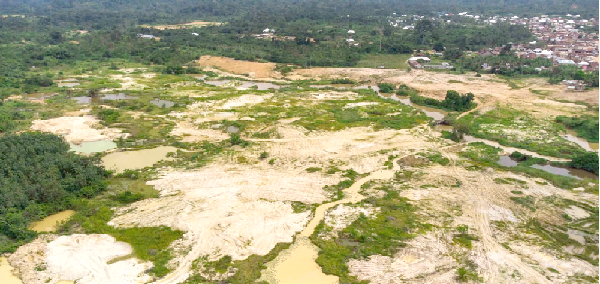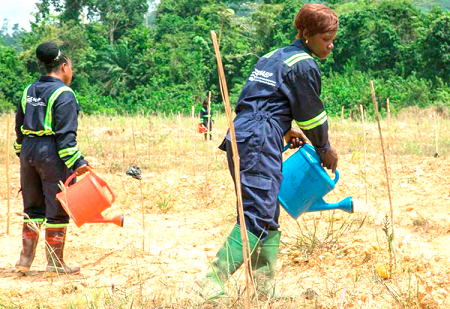
Galamsey: Healing our land, restoring our future
He was one of the bitterest enemies of the state. Ghana’s Minerals and Mining Act, 2006 (Act 703), as amended by the Minerals and Mining (Amendment) Act, 2019 (Act 995), forbids mining in forest reserves, water bodies or without licence.
Advertisement
But the 52-year-old Yaw Nkrumah and thousands others defied the law with impunity. Armed with excavators, toxic chemicals, such as, cyanide and mercury, they destroyed agricultural lands, forest reserves and left water bodies heavily polluted. They left behind uncovered pits which were death traps for residents of mining communities.
It was this enemy of the state that I met on February 6, 2023; but this time around, he was a friend of the environment. He now works with a land reclamation project to restore lands that have been degraded through illegal mining activities.
When I met him at Asawinso in the Bibiani-Anhwiaso-Bekwai Municipality in the Western Region, he and 50 others were busily watering seedlings and controlling weeds on a 139-hectare degraded land that had been reclaimed.
Mr Nkrumah said ever since he was recruited to work under the land reclamation component of the National Alternative Employment and Livelihood Programme (NAELP) in October 2022, he has been a changed person.
"I was blind. I did not know that by harming the environment, I was harming myself and the future of my six children. Now, I can see; and I have pledged never to engage in illegal mining," he indicated.
A 45-year-old woman, Agnes Ackah, who, until October 2022, was also neck-deep in galamsey, was on a confession spree: “I have destroyed the environment for many years, with nothing to show. Since i joined the reclamation project, I have something to live on, I pay my children's school fees, and I can sleep with a clear conscience," she said.
NAELP

Some beneficiaries of the NAELP reclamation project watering economic trees planted on reclaimed lands at Asawinso in the Western North Region
The government launched the NAELP in 2021 as part of national efforts to curb illegal mining. One of the modules under the programme is the national land reclamation programme, targeted at reclaiming degraded lands closer to water bodies.
Under the NAELP reclamation project, over 1,000 hectares of degraded lands are being reclaimed in mining communities in the Ashanti, Western North and Eastern regions.
A private company, Dredge Masters Ghana Limited, is reclaiming about 500 hectares of the degraded lands located at four sites in the Western North Region. My visit to the four sites —
Asawinso site A and B, Mpesiem and Antobia, in the Bibiani-Anhwiaso-Bekwai Municipality, Sefwi-Wiawso and Juaboso districts respectively, showed that the entire work was more than 90 per cent complete. Earthworks had been completed at the Asawinso sites A and B, as well as Mpesiem while the Antobia site was 90 per cent done.
At the time I got to the two sites at Asawinso around 10a.m. on Monday, February 6, the site manager of the NAELP reclamation project, Gilbert Atima (G.A), was on site. I engaged him in the following conversation:
Timothy Ngnenbe (TN): What was the situation here before you started work?
G.A: The destruction to the land at this place was terrible. The gullies were deep and filled with water. When we examined the extent of work to be done, we knew we were in for real work.
TN: Walk me through the reclamation process.
G.A: We mobilised four excavators, eight dozers and other equipment to this site. We created access routes to the project sites and started dewatering, a process which involves draining the pits of water. This process allowed us to get a clear picture of how deep the pits were and how we can fill them. We went on to backfill it with excavated pit materials, and in situations where we could not find the materials, we imported by looking for farmers who had good materials, paid them and used their materials to fill the pits. After backfilling, we had to fill the top with good soil which can support plant growth, and planted some economic trees on the land.
TN: Did you encounter any challenges working on this project?
G.A: Some pits were hidden because they were excavated from underground, so by the time you realise, the equipment will fall into it and get stuck. Sometimes, we spend a whole day to get a machine out. Some illegal miners also use all means to prevent us from reclaiming the lands. Some of them confronted us and said that was their only source of livelihood so nothing could stop them. There have been instances where some of the galamsey operators approached us to use our equipment for illegal mining, but we told them that our duty was to reclaim degraded lands and not to get involved in galamsey. The security agencies gave us protection, so we overcame the challenge.
Benefits
My interactions with the residents of these mining communities showed that apart from creating alternative livelihood for them, they were particularly happy that their lands would be restored.
“We endorse the reclamation project because it will save our children from falling to death in mining pits,” a Chief (Odikro) of Sefwi Mpesiem, Nana Nkansah Obirimpong II, said.
A specialist in artisanal small-scale mining (ASSM), Yaw Biritwum Opoku, said when mined lands were reclaimed, they served as wildlife habitat, agricultural lands and help to create carbon sink, which contributes to addressing climate change.
An expert in collaborative natural resource management, Daryl Bosu, observed that reclamation of land after every mining enterprise is crucial because it ensures that when the gold is gone, we can still benefit from the land for purposes of food security and other ecosystem services.
Action
Mr Bosu said while the efforts being made to reclaim degraded lands were commendable, there was the need for advanced planning to reclaim lands as companies mined.
The environmentalist also underscored the need to integrate the Polluter Pay Principle into the country’s mining regulations and operations such that every company will be required to set aside, in advance, some amount of money or resources for land reclamation.
This view expressed by Mr Bosu is catered for by Regulation 23 of the Environmental Assessment Regulations, 1999 (L.I. 1652), which requires the Environmental Protection Agency (EPA) to make sure that prospective small-scale miners post reclamation bonds in the form of cash into an escrow account based on approved reclamation plans.
Regulations 472 (2c) of the Minerals and Mining (Health, Safety and Technical) Regulations, 2012 (L.I. 2182) also requires the Inspectorate Division of the Minerals Commission to ensure that prospective small-scale miners submit an operating plan, together with other requirements, for acquisition of SSM operating permit.
The plan explains how the miners intend to rehabilitate the mined areas by detailing the methods and procedures for revegetation. Unfortunately, these regulations have not been enforced, almost 23 years after their enactment.
It will be an exercise in futility if a colossal amount of money is sunk into reclamation of degraded lands only for illegal miners to continue destroying land and forest reserves with impunity.
The regulatory agencies must strictly enforce these laws to ensure that no small-scale mining company leaves behind uncovered mining pits. There is also the need for stronger collaboration between state agencies, traditional authorities, who are the custodians of land, and residents of mining communities to halt illegal mining activities so as to save the environment from further destruction.
Writer’s E-mail: [email protected]



